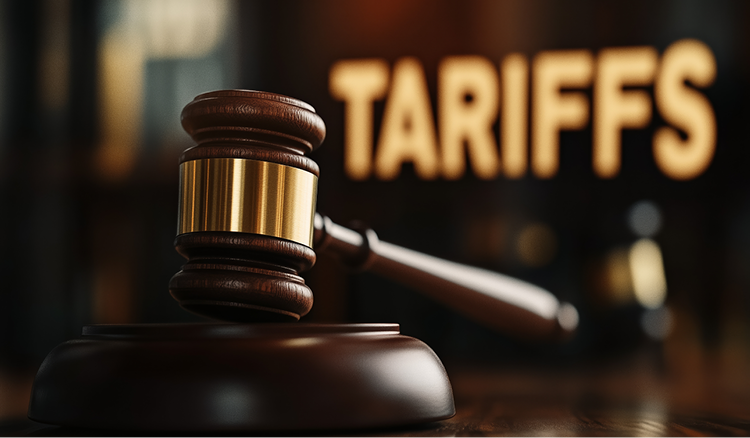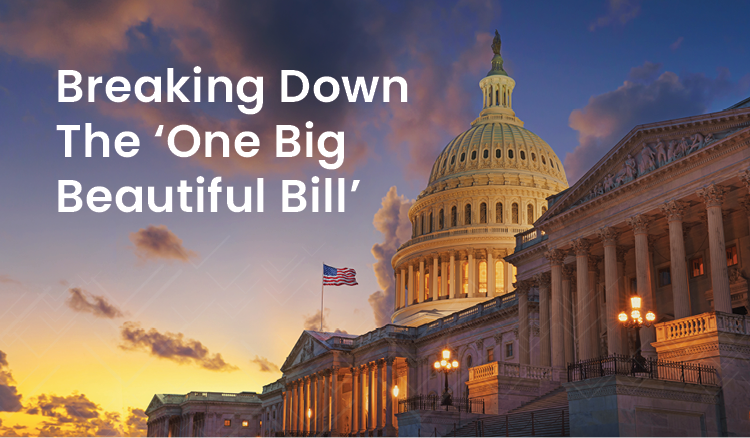Trump 2.0 Week 19 In Review: Discussing The Federal Court Blockage of Trump's Tariffs, Other Trade War Related Developments, and More
It’s been a busy week in the world of trade policy. From the looming threat of new tariffs on smartphones to the postponement of the 50% EU tariff, and a federal court ruling blocking Trump’s tariffs — there’s been a lot happening.
If you haven’t had time to catch up on everything, don’t worry. We’ve put together another comprehensive article that breaks down all the recent updates and what they mean.
Topics covered this week include:
- The Federal court blockage of Trump’s tariffs and the subsequent reinstatement
- Trump’s recent claim that China has violated its trade agreement
- The postponement of the 50% EU tariff
- Trump’s threat of new tariffs on Apple & Samsung
- What's next for the One Big Beautiful Bill
- New investments in U.S. manufacturing
- Why operational agility is crucial to survival right now
U.S. Trade Court Blocks Trump’s Tariffs, Then Appeals Court Reinstates Them
On Wednesday evening, a U.S. Federal Court ruled that some of President Trump’s tariffs imposed under the IEEPA are unlawful because they exceed the president’s constitutional authority.
Specifically, The New York based Court of International Trade invalidated Trump’s "Liberation Day" tariffs and other fentanyl-related duties on countries like China, Mexico, and Canada, stating that the law does not empower the president to unilaterally impose such sweeping import taxes. The ruling was based on lawsuits filed by the nonpartisan Liberty Justice Center on behalf of small businesses and a coalition of U.S. state governments, challenging the legality of the tariffs.
On Thursday morning, a second federal court blocked Trump’s attempts to impose tariffs. This decision however, has little practical effect since the U.S. Court of International Trade already blocked these tariffs. Ruling Judge Rudolph Contreras also rejected the Trump administration’s effort to consolidate related cases, allowing challenges to proceed in Washington, D.C., amid differing rulings elsewhere.
Later on Thursday however, a federal appeals court temporarily paused the trade court ruling, granting the Trump administration's request for a stay while it prepares to appeal. The court's order delays the enforcement of the trade court’s decision until further notice, providing the administration time to seek emergency relief from the Supreme Court if needed. The court also set a one-week deadline for plaintiffs, including state attorneys general and businesses, to respond to the administration’s stay request, with the U.S. government expected to reply by June 9.
As far as how this will impact ongoing negotiations with key trade partners, White House Trade Advisor Peter Navarro told reporters following the order that “The pause will not affect the negotiations in any way if people out there in the world simply look at the court decision. The court was clear, as I said, that [the] President has broad authority to impose tariffs.” He also stated “This morning, we were getting plenty of phone calls from countries saying, ‘We saw the rule,’ and so what we’re going to continue to [do is] negotiate in good faith.” As of now, a fourth round of talks with Japan is set for Friday in Washington, and a trade negotiating team from India is headed to the U.S. next week for talks.
Overall, while this is certainly a major setback for Trump, his team seems confident they can win this legal battle. And if not, the administration has already indicated it will pursue alternative legal routes to reimpose tariffs.
Trump Claims China Violated Trade Deal With U.S.
Early Friday, President Trump accused China via TruthSocial of violating a recent trade agreement with the U.S., raising concerns about the potential for a renewed trade conflict. The recent agreement, which reduced tariffs between the two countries, was seen as a very positive step in the right direction. These recent comments however, from Trump as well as the U.S. Treasury Secretary Scott Bessent indicates that these negotiations may have stalled.
While Trump didn't initially clarify what action China took that violated the agreement, U.S. Trade Representative Jamieson Greer has since stated that China has not been removing non-tariff barriers as agreed under the deal. While Beijing's initial did not address the U.S. claims directly, they did however urge the U.S. to "cease discriminatory restrictions against China".
Trump Postpones 50% EU Tariff
Last week after the EU sent the U.S. a revised trade proposal, President Trump announced plans to impose a 50% tariff on EU imports starting June 1, in an effort to pressure the EU into faster talks.
On Sunday however, following a phone call with European Commission President Ursula von de Leyen, Trump announced his plans to delay the 50% tariff until July 9. He also announced shortly after on Truth Social that “talks will begin rapidly.”
While no meetings are on the books as of now, this will likely change in the next week given Trump’s Tuesday post on Truth Social stating “I have just been informed that the E.U. has called to quickly establish meeting dates.”
For context, the trade deficit with the EU amounted to more than $236.5 billion in 2024, up 12.9% from the year before.
Trump Threatens Apple & Samsung With Tariff On Smartphones Produced Overseas
Last Friday after we published last week’s recap article, President Trump released a TruthSocial post criticizing Apple’s plans to produce iPhones in India, and demanding they as well as other smartphone manufacturers like Samsung produce their devices in the U.S. or face a 25% tariff.
This comes after Trump’s statements last week during his Middle East trip where he expressed disappointment with Apple CEO Tim Cook over the company’s plan to manufacture iPhones at newly built plants in India.
Roughly 90% of Apple’s iPhone production and assembly is based in China, according to Wedbush Securities’ estimates. Due to tariffs however, which Apple CEO Tim Cook claimed could cost them $900 million this quarter, the company has worked to diversify its production capabilities and move production to India. In April, iPhone shipments from India to the U.S. were up 76%, and Cook on Apple’s earnings call with investors earlier this month said he expected “the majority of iPhones sold in the U.S. will have India as their country of origin.”
Overall, this latest tariff threat aligns with broader efforts to strengthen U.S. supply chains, especially for semiconductors. Treasury Secretary Scott Bessent recently highlighted the importance of this, stating: “I think that one of our greatest vulnerabilities is this external production, especially in semiconductors, and a large part of Apple’s components are in semiconductors. So we would like to have Apple help us make the semiconductor supply chain more secure.”
While Apple hasn’t yet directly responded to these threats, this will likely change in the next week.
The One Big Beautiful Bill
As we wrote about in last week’s article, the “one big beautiful bill” has passed the House of Representatives by a narrow margin. With opposition from fiscal hawks and moderates alike however, the bill faces a complex path through the Senate, where bipartisan and intra-party negotiations will be crucial to its future. With that being said, these disagreements aren’t related to the pro-manufacturing provisions of the bill. Senate Majority Leader John Thune aims to pass the bill by July 4, contingent on securing enough votes, including from some senators wary of certain provisions.
To learn more what this bill could mean for your business check out our new podcast: U.S. Manufacturing Today. In episode 11 which dropped earlier this week, host Matt Horine dived deep into the details of this bill and what it means for U.S. manufacturers and distributors.
More New Investments in U.S. Manufacturing
Despite what critics say, companies continue to announce new investments in U.S. manufacturing.
Below are some of the most notable recent announcements. For a full list of all 60+ major announcements since the start of Trump 2.0, click here.
Eli Lilly and Co. Considers Houston For One Of Its 4 Planned New U.S. Plants
Pharmaceutical giant Eli Lilly is considering a $5.9 billion biomanufacturing facility at Generation Park in Northeast Houston, which, if approved, would be one of the largest life sciences investments in Texas history. The new plant is expected to create approximately 600 permanent jobs, along with around 2,000 temporary construction jobs. Located within the 4,300-acre Generation Park business hub, the facility would significantly expand Eli Lilly’s domestic production capacity, and would bolster Houston’s reputation as a growing center for biotechnology and advanced manufacturing.
This project aligns with Eli Lilly’s broader global expansion efforts to enhance supply chain resilience and meet increasing demand for biologics. The company has previously invested heavily in North Carolina, and the Houston facility would play a crucial role in strengthening domestic capabilities and improving the U.S. pharmaceutical supply infrastructure. Not to mention the significant benefits it would bring to the region’s economy. Read more.
AVL Manufacturing Chooses Charlotte NC As Location For First U.S. Factory
On Wednesday, AVL Manufacturing, Inc. ("AVL"), a Canadian-based manufacturer of power generation and storage enclosures, announced it has chosen Charlotte, NC as the company's first U.S. manufacturing location. The planned 232,000-square-foot facility is expected to open in September 2025 and will create at least 300 new jobs and inject $56M+ in the local economy. Read More.
CBC Global Ammunition Chooses Oklahoma for New Factory
CBC Global Ammunition, a leading manufacturer of portable weapons ammunition, recently announced plans to establish a $300 million manufacturing operation in Pryor, Oklahoma, which is expected to generate around 350 jobs. The new facility will be built on more than 550 acres at MidAmerica Industrial Park and will produce a full range of centerfire cartridges, from 9mm to 12.7mm, with in-house production of all components, propellant, and raw materials.
This initiative is seen as a significant boost to Oklahoma’s aerospace and defense industries, with state officials emphasizing the collaborative effort behind its success. Oklahoma Department of Commerce CEO John Budd praised the partnership between government and industry, noting the project’s importance for local economic development and national defense. Overall, the project positions Oklahoma as a strategic hub for ammunition manufacturing and defense-related industries, reinforcing the state’s role in supporting national security and economic growth. Read More.
Veryable Was Built For This Moment in Time
With the events of this past week, things have never been more uncertain. In this environment, operational agility is no longer just a competitive advantage, it’s truly a necessity for survival.
Veryable’s on-demand labor model is essential for businesses seeking to maximize agility and stay ahead of the curve. By providing the ability to adjust headcount daily, Veryable removes the limitations imposed by traditional staffing models, empowering companies to remain agile and ready to take on whatever comes their way without incurring unnecessary costs.
Here’s how:
Scalability in Days, Not Weeks – Instead of spending weeks on emergency hiring sprees or taking a gamble with staffing agences, businesses can find pre-vetted workers today for tomorrow’s needs with Veryable. This allows for instantaneous expansion of operations as market conditions change. Furthermore, building a flexible workforce helps businesses create down cycle agility by giving them the ability to scale down immediately if the need arises.
Peak Demand Readiness At All Times Without Inflated Fixed Costs – With Veryable, businesses can quickly scale up to handle surges in demand without having to worry about whether higher demand will persist. It’s truly the best of both worlds - unlimited capacity on days it’s needed without margin erosion on slower days.
Higher Throughput & Efficiency – Being able to match headcount to demand daily eliminates bottlenecks and inefficiencies, allowing businesses to maximize throughput and operate at peak efficiency regardless of daily volume.
To learn more about the Veryable solution, visit our main page. For information tailored to your exact role, click here.
U.S. Manufacturing Today Podcast
Hosted by our Head of Reindustrialization, Matt Horine, and featuring interviews with leading industry experts, this podcast intends to help you cut through the noise of pervasive narratives and offer clarity on the significant policy shifts shaping the U.S. manufacturing sector.
This week’s episode was all about the “one big beautiful bill” and what it means for U.S. manufacturing.
You can find this podcast on our website, Spotify, Apple, YouTube, and PocketCasts.
Additional Resources
For more insights on the developments under Trump 2.0, be sure to visit our “Navigating Trump 2.0” page. There, you’ll find comprehensive information on recent & potential future changes, and a collection of articles offering guidance for manufacturers and distributors on how to win in this uncertain environment.
Previous Posts
Flexibility vs. Agility in Operations: Understanding the Differences and Why You Need Both
The Future of Manufacturing and Logistics
Create a free business profile today to explore our platform.






